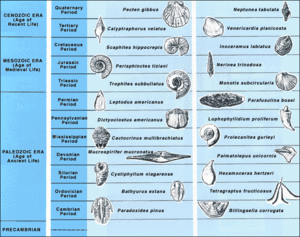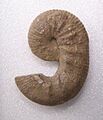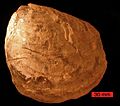Index fossils facts for kids
Index fossils are special fossils that help scientists figure out the age of rock layers. Think of them like time markers in the Earth's history! They are also called guide fossils or zone fossils.
Even if different rock layers look different, they might contain the same type of index fossil. If that fossil came from a species that lived for only a short time (in Earth's long history, this means a few hundred thousand years), then we know those rock layers were formed during that specific time. The shorter the time a species lived, the more accurately we can date the rocks.
The best index fossils have a few important features:
- They were very common.
- They are easy to identify.
- They lived in many different places around the world.
Ammonites are a great example of index fossils. They were sea creatures with spiral shells that lived millions of years ago. Other important groups of index fossils include corals, graptolites (tiny colonial animals), brachiopods (shellfish), trilobites (ancient sea bugs), and echinoids (sea urchins). Even fossilized teeth from mammals can be used!
Contents
How Scientists Use Index Fossils
Scientists who study rocks and Earth's history are called geologists. They use index fossils to understand the geologic periods of our planet. This process is known as biostratigraphy.
Geologists look for two main types of fossils:
- Macrofossils: These are large fossils that you can easily see with your eyes in the field.
- Microfossils: These are tiny fossils that you need a microscope to see.
While macrofossils are easy to spot, microfossils are very common. Because of this, microfossils are often used by companies looking for mineral resources like oil. They need to know the exact age of the rocks they are exploring.
Index Fossils and Time Zones
When a specific index fossil is found in a series of rock layers, that whole section is often called the "zone" of that fossil. This helps scientists connect different groups of animals and plants that lived at the same time, even if they were found in different places.
For example, scientists might say that a certain type of trilobite, like Mesolenellus hyperborea, lived during the late Nevadella-zone. This helps them understand when different creatures lived and how life changed over millions of years.
Examples of Common Index Fossils
Here are a few examples of index fossils and the time periods they represent:
- Calico Scallop (Pecten gibbus or Argopecten gibbus): This scallop lived during the Quaternary Period, which started about 1.8 million years ago.
- Viviparus glacialis (a type of snail): This snail is an index fossil for the Tiglian stage, which was part of the Early Pleistocene Epoch, about 2.3 to 1.8 million years ago.
- Scaphites (Scaphites hippocrepis): This ammonite is a key index fossil for the Cretaceous Period.
- Inoceramus (Inoceramus labiatus): Another important fossil from the Cretaceous Period.
- Perisphinctes (Perisphinctes tiziani): This ammonite helps identify the Jurassic Period.
- Leptodus (Leptodus americanus): This brachiopod is an index fossil for the Permian Period.
- Mucrospirifer (Mucrospirifer mucronatus): This brachiopod helps identify the Devonian Period, which was from about 416 to 359 million years ago.
- Paradoxides (a type of trilobite): This trilobite is an important index fossil for the Cambrian Period, specifically between 509 and 500 million years ago.
- Archeocyathids: These ancient sponge-like creatures are index fossils for the Lower Cambrian period, from about 529 to 509 million years ago.
Images for kids











